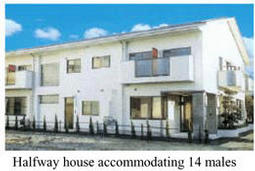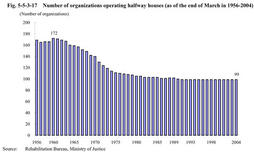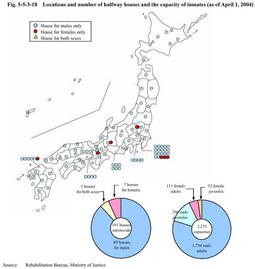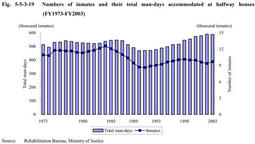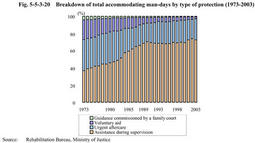| Previous Next Index Image Index Year Selection | |
|
|
2. Halfway houses A halfway house is an institution to accommodate parolees,probationers and discharged offenders who need protection while they rehabilitate themselves.It provides them with a place to stay,meals,education,training,medical care,job assistance,and living guidance necessary for them to adapt to society.A large number of parolees,probationers,and prisoners released upon completion of their sentences have no place to return after release from prisons.It plays an indispensable role as a launching pad for them to further rehabilitate themselves in society.While living in a halfway house,a parolee or probationer makes preparations for leading an independent life through getting a job and finding a place to live.
Although laws permit the national or municipal government to operate halfway houses,none of them run such houses.All the101halfway houses in Japan are managed by private juridical persons licensed by the Minister of Justice.They are commissioned by the state(the head of a probation office)to protect released offenders. Halfway house accommodating 14 males The following section briefly explains halfway houses,which play a role as important as that of volunteer probation officers in rehabilitation services by the private sector.(1) Number of halfway houses and their capacity Fig. 5-5-3-17 shows the number of organizations that operate halfway houses as of the end of March each year.The number has constantly decreased from172in1960,mainly due to deterioration in management bases and aging of facilities.As of the end of March2004,99juridical persons for offenders rehabilitation services operated101halfway houses.
Fig. 5-5-3-18 illustrates the locations of halfway houses and their capacity of accommodation as of April1,2004.Almost90%houses were only for males and about80%of their accommodation capacity was for adult males.The average capacity was22.3persons,indicating that most houses are relatively small. Fig. 5-5-3-17 Number of organizations operating halfway houses(as of the end of March in1956-2004) Fig. 5-5-3-18 Locations and number of halfway houses and the capacity of inmates(as of April1,2004) (2) Staff members Such people as a manager of house,an assistant manager,guidance officers,and cooks work at each halfway house.As of April1,2004,the total number of halfway house staff was581(including part-time workers)with the average age of60.3.The average number of staff per halfway house was5.8.Of the581total staff members,101or17.4%live in the halfway houses,and381(65.6%)are commissioned as volunteer probation officers(Source:Rehabilitation Bureau,Ministry of Justice).
The data reveals that a small number of relatively old staff have to tackle the difficult job of helping and supervising offenders and delinquents at halfway houses under harsh working conditions including night duties. (3) Number of inmates at halfway houses Fig. 5-5-3-19 shows the number of inmates(line graph)and total man-days(bar graph)accommodated in halfway houses each year sine1973.A total of9,695inmates were accommodated,with total accommodating man-days being 588,846 in FY2003.In recent years,the number of accommodated inmates has leveled off,while the accommodating man-days have increased constantly,indicating that inmates tend to spend a longer time in halfway houses than before due mostly to the worsening employment situation amidst the stagnant economy.
Fig. 5-5-3-19 Numbers of inmates and their total man-days accommodated at halfway houses(FY1973-FY2003) Fig. 5-5-3-20 shows a breakdown of the annual number of total accommodating man-days in halfway houses since1973by type of protection.In the figure,almost all people in the category of"assistance during supervision"are parolees/probationers,and voluntary aid refers to protection voluntarily offered by halfway houses to those offenders who are no longer subject to urgent aftercare or to any protection commissioned by the state.Since1973,the percentage of parolees/probationers has risen considerably.On the other hand,the proportions of those under"voluntary aid"have decreased.In FY2003,parolees/probationers accounted for72.5%of the total,while those under urgent aftercare and voluntary aid accounted for24.6%and2.4%respectively.This data indicates that halfway houses have been shifting their main activities from voluntary aid and urgent aftercare to probation/parole supervision. According to a breakdown of parolees/probationers entrusted to halfway houses in2003,adult parolees accounted for as much as84.1%of the total,adult probationers accounted for9.9%,juvenile parolees for4.2%,and juvenile probationers for1.7%(Source:Annual Report of Statistics on Rehabilitation). Fig. 5-5-3-20 Breakdown of total accommodating man-days by type of protection(1973-2003) (4) Enhancement of treatment function in halfway houses In1994,a new system was established to give halfway houses subsidies to promote renovation of their aging facilities.In1996,the Law for Offenders Rehabilitation Services was enforced to establish Juridical Persons for Offenders Rehabilitation Services was enforced. Table 5-5-3-21 shows the number of halfway houses that have received subsidies and rebuilt or renovated their facilities since1994.
As the facilities of halfway houses have been improved,a basic plan was established in2000to improve the treatment function provided in halfway houses.In2002,the Law for Offenders Rehabilitation Services was revised to specify that living guidance necessary for offenders'successful social adaptation must be provided as a part of rehabilitation services.Since this revision,halfway houses have been given greater recognition as places to provide offenders with their treatment programs. Table 5-5-3-21 Number of halfway houses rebuilt or renovated(1994-2003) Under this backdrop,halfway houses have tried to improve the contents of their treatment programs,taking into consideration the uniqueness and advantages of their facilities.For example,some halfway houses have introduced Social Skills Training(SST)programs,educational lectures on the hazards of alcohol and drugs in collaboration with related institutions and organizations outside,collage therapy,group workshops to improve a parent-child relationship,and counseling services by outside counselors.SST programs have rapidly spread among halfway houses in particular.As of April1,2004,a total of35halfway houses have offered SST programs(Source:Rehabilitation Bureau,Ministry of Justice).(5) Cooperation with local communities As halfway houses are located in local communities,it is very important for them to establish and maintain cooperative relationships with local residents as the basis of effective treatment for their inmates.They have,therefore,taken various measures by cooperating with volunteer probation officers,Women's Associations for Rehabilitation Aide or BBS associations.They hold events,e.g.rice-cake making events,bon festival dances,and child-rearing support lectures,in which local people are invited to participate,or open their meeting rooms or libraries for local people to use.
(6) Conclusion Halfway houses were once mere shelters that simply provided accommodation and meals to those offenders whose prospects for rehabilitation are bleak due to their poverty,but now they provide offenders also with comprehensive treatment programs to facilitate their social reintegration.In2003,one in four parolees stayed in halfway houses as their first step in society(see Fig. 5-5-2-9 ).Halfway houses have come to play an indispensable role in operating the parole and probation system.Though they usually go unnoticed,halfway houses have made a tremendous contribution to the security of Japan.They give an answer to the question of where to care and how to rehabilitate those offenders and delinquent juveniles who have no one to turn to.Improvement of the function of those houses is a key to effective treatment of offenders.
Column What is SST? SST is an acronym for the treatment method known as Social Skills Training.While there are a number of treatment methods such as counseling and psychotherapy,SST is a type of cognitive behavior therapy,which focuses on behavioral problems and thinking patterns(cognition)of the person in question and uses the findings to improve them.SST is conducted at halfway houses and also at juvenile training schools and other institutions. Not a few offenders staying in halfway houses have difficulties in establishing good human relationships or keeping their jobs because they do not know how to communicate with others or express themselves.SST helps those offenders develop their social abilities,such as the ability to communicate with others,express themselves,and solve their problems.SST makes them to recreate and act out many scenes that they may experience after leaving the halfway house.Those scenes cover job interviews,turning down an invitation to go drinking or gambling,feeling stress at work,getting into trouble with others.Participating members act themselves,watch others acting out the scenes to evaluate their playing and exchange opinions later. SST is conducted as follows.A staff member of a halfway house plays the role of organizer and establishes the SST group,consisting of about ten persons.In each session of SST,five to six teams of participants perform role-plays.They can have confidence if their plays receive a good evaluation from other participants.If they receive a comment such as"you should have spoken in a louder voice,"they can learn how to improve themselves.SST uses roll-plays to teach participants how to act in a job interview and how to establish good human relationships in their workplace.SST is also useful in enhancing communication between staff members and inmates as well as among inmates in halfway houses.Thanks to detailed instructions given in the SST program,inmates can improve their chances of successful social rehabilitation. |
